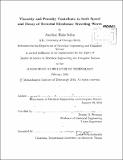Viscosity and porosity contribute to both speed and decay of tectorial membrane traveling waves
Author(s)
Sellon, Jonathan Blake
DownloadFull printable version (7.546Mb)
Other Contributors
Massachusetts Institute of Technology. Department of Electrical Engineering and Computer Science.
Advisor
Dennis M. Freeman.
Terms of use
Metadata
Show full item recordAbstract
The tectorial membrane (TM) is thought to play a critical role in stimulating cochlear hair cells. Recently, it has been shown that the tectorial membrane supports traveling waves [14] and that these waves may contribute to cochlear tuning and sensitivity by longitudinally coupling radial cross sections [15]. While previous work examined how TM wave properties may impact a variety of hearing properties, the molecular origins controlling wave propagation are still unclear. To better understand molecular mechanisms, I examined the role of porosity and viscosity in wave propagation. Wave properties were measured for mouse TMs immersed in artificial endolymph solutions with poly-ethylene glycol (PEG) added to increase viscosity. Two PEGs with different molecular weights (MW) were used: one (8 kDa) chosen to penetrate TM pores [30] while the other (400 kDa) could not. Findings show that introducing small MW PEG increases TM wave speeds by -38% and decreases wave decay constants by -42%. Analysis of a lumped parameter model of the TM showed that these changes in wave parameters can be explained by a change in shear viscosity from ~0.2 Pa*s to ~0.65 Pa*s with no accompanying change in shear modulus. In contrast, introducing large MW PEG has little effect on wave speed (~2%) or decay (-9%), suggesting shear viscosity inside the TM is significantly more important compared to fluid viscosity. This result suggests that fluid surrounding the TM has two separate effects on TM motion. First, increasing fluid viscosity has the obvious effect of increasing drag on the surface of the TM. In addition, if high viscosity fluid penetrates the TMs porous structure then the TMs material properties are also directly affected. Of these two effects, the latter has a much greater impact on TM waves. Thus, the porosity of the TM may play a critical role in cochlear mechanics.
Description
Thesis (S.M.)--Massachusetts Institute of Technology, Dept. of Electrical Engineering and Computer Science, 2013. Cataloged from PDF version of thesis. Includes bibliographical references (p. 61-64).
Date issued
2013Department
Massachusetts Institute of Technology. Department of Electrical Engineering and Computer SciencePublisher
Massachusetts Institute of Technology
Keywords
Electrical Engineering and Computer Science.